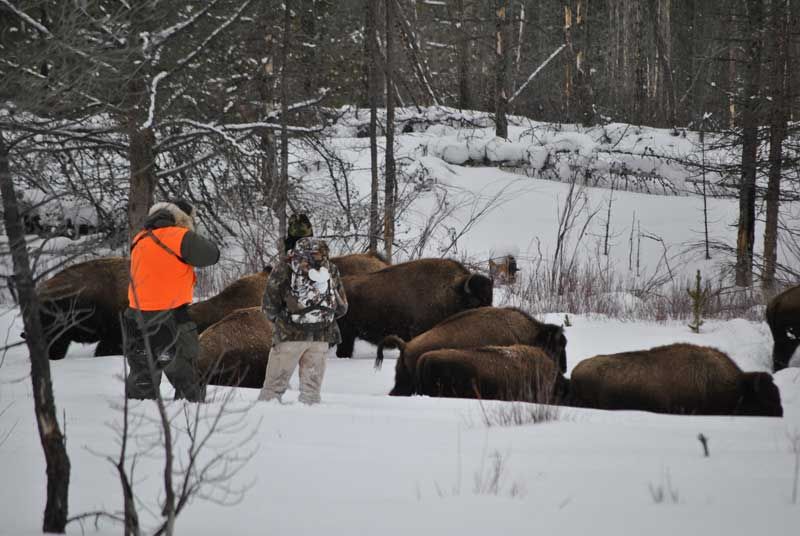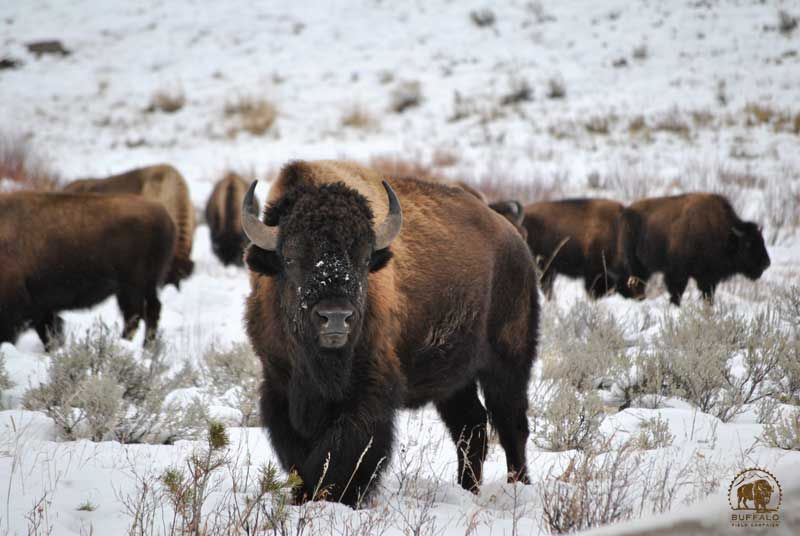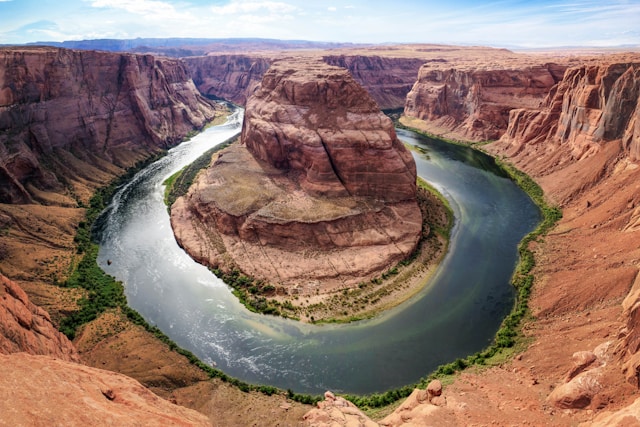
by Deep Green Resistance News Service | Feb 12, 2018 | Biodiversity & Habitat Destruction
by Max Wilbert / Deep Green Resistance
This morning, I spent four hours lost in an industrial neighborhood in Pocatello, Idaho. I was carrying two bags and a box full of food—altogether about 70 or 80 pounds—the wind was howling through the flat grey morning, and I must have covered five miles before I found the coffee shop that I’m sitting in right now.
Explaining why I am here requires that we go back almost 200 years. By the mid-1800’s, the U.S. empire was growing rapidly and expanding west. As guns and horses spread across the Great Plains, bison herds began to fall to hunters and settler-colonists in need of hides. At the same time, industrialism was expanding. Factories used buffalo leather straps as a strong yet elastic material to drive belts on their machines, which means that the bison were literally killed to drive machines.
By the year 1902, there were only 23 bison alive on this continent who took refuge in Pelican Valley in what is now Yellowstone National Park. This means that between 30 and 60 million had been killed in less than 100 years, most of them in less than 20 years. That’s a survival rate of less than one in ten million, or 0.0000007 percent.
The removal of the bison allowed cattle ranching to expand and allowed the U.S. army to force the powerful plains nations onto reservations. The removal of the native nations to reservations via a series of concentration camps allowed settlers to move in.
Over time, with the establishment of Yellowstone National Park and surrounding wilderness areas, the last 23 bison were able to expand their populations. Today, there are around 4,700 bison in the Yellowstone area who are direct descendants of those final 23 survivors.
At this point, you might be forgiven for thinking that as a society, we’ve learned better, and now we protect wild buffalo—especially within Yellowstone. The reality is the opposite. Over the past 33 years, government agencies including the National Parks Service and U.S. Fish and Wildlife Service have used our tax dollars to kill more than 10,000 wild bison in and around Yellowstone. In service of livestock interests, Yellowstone National Park has, in the words of my friend Stephany Seay, “more wild buffalo blood on their hands than anyone since the 19th century.”
Today the U.S. Government continues its 200-year-old war against the bison by herding, baiting, and hazing them into a trap located on the North Side of Yellowstone National Park. Here, they are kept for months, subjected to invasive medical procedures (including sterilization experiments), and then murdered. In the past few months, 169 bison have been killed (and counting).
The justification for this slaughter is misguided “management plans” which are heavily influenced—written, more or less—by the ranching industry lobbyists. As was true in the 1800’s, cattle reign supreme in Montana today, and bison pay the price. Idaho is the same. They have a “zero tolerance policy,” which means that any buffalo who enter Idaho are tracked down and killed.
Just so we’re clear, this slaughter is preventing the Yellowstone bison herds from naturally expanding their population into suitable habitat in adjacent National Forests. There is enough land and food and water for the bison, but the cattle barons want all of it
I’ve written and said many times before that we’re living in a war, and that the dominant culture (capitalism, industrialism, civilization, whatever you want to call it) is destroying the planet.
Most people in this culture don’t acknowledge this war, and as the saying goes, “silence is complicity.” Once you understand this war, continuing to stand aside is a betrayal to the planet. There are, however, thousands of people around the world who do acknowledge that this is a brutal war, and that we need to fight back.
These people include the organizers of Buffalo Field Campaign. Buffalo Field Campaign is a grassroots campaign that was founded by Lakota activist Rosalie Little Thunder and activist videography Mike Maese in the winter of 1996-7, when more than a thousand bison were slaughtered by the National Parks Service and Montana Department of Livestock.
Over the intervening 21 years, Buffalo Field Campaign has worked through advocacy, whistleblowing, lawsuits, and direct action to protect the last remaining wild bison in Yellowstone.
I’m on my way right now to Yellowstone. I don’t have a car to travel with, so I rented a one-way vehicle to Pocatello, where another group of friends will pick me up. There are seven or eight of us converging on Yellowstone to express our solidarity, bring donations and supplies, and join in the fight to protect bison.
I’ve often heard the saying that the life of a soldier is 99 percent waiting, and one percent overwhelming terror. In my experience, the life of a revolutionary organizer in the modern world is much the same. We need to prepare, write, organize, build our groups and political consciousness, and gain more resistance skills. Much of this work is boring, dangerous, or downright exhausting.
This morning, after driving through the day yesterday and sleeping on a friend’s grandmother’s couch (thanks for the bag lunch, Lois!), I woke up before 6, jumped in the car, and drove the middle leg of my trip. After dropping the rental car in a tiny, dingy office in the middle of an industrial park covered in trash and tumbleweeds, I had two options: sit awkwardly in the corner for a few hours, or shoulder all my bags, zip up my down jacket, grab my food box, and push open the squealing front door, and try to find my ways sans-GPS to a coffeeshop to get some writing done.
That’s why I was lost on the streets of Pocatello, Idaho this morning.
by Deep Green Resistance News Service | Dec 2, 2017 | Biodiversity & Habitat Destruction
by Earthjustice / Ecowatch
The Trump administration released on Wednesday its long-overdue recovery plan for Mexican gray wolves, one of the most endangered mammal species in North America with an estimated wild population of just over 100. However, the plan charts a course for extinction rather than recovery, cutting off wolf access to vital recovery habitat and failing to respond to mounting genetic threats to the species.
“It’s a ‘recovery plan’ in name only. Without additional habitat and greater genetic diversity, the wolves will continue to teeter on the brink of extinction. The plan provides none of these essential needs,” said Heidi McIntosh, an attorney with the nonprofit environmental legal organization, Earthjustice, which sued the federal government on behalf of conservation organizations.
The Trump administration refused to listen to the tens of thousands of people who asked them to fix their awful draft plan before finalizing it. Among the people who weighed in asking for stronger protections for the wolves were concerned citizens, business owners and scientists.
“Lobos waited decades for a plan to save them, only to be given one that does not guarantee recovery,” said Bryan Bird, Southwest director for Defenders of Wildlife. “The U.S. Fish and Wildlife Service had the opportunity to build a plan on a foundation of science and conservation, but instead decided to let politics rule.”
“Instead of moving forward with a plan based on legitimate, science-based recommendations, the Service collaborated exclusively with the very states that have gone to extraordinary lengths to obstruct Mexican wolf recovery,” said Maggie Howell of the Wolf Conservation Center. “Critically endangered lobos deserve better.”
“The Fish and Wildlife Service published over 250 pages of supporting ‘scientific’ justification, used a sophisticated model to predict extinction probabilities, then tossed the science aside and asked the states how many wolves they would tolerate with no scientific justification whatsoever,” said David Parsons, former Mexican wolf recovery coordinator for the Fish and Wildlife Service. “Using the states’ arbitrary upper limit as a population cap in the population viability model and forcing additional recovery needs to Mexico, the plan will guarantee that from now to eternity no more than a running average of 325 Mexican wolves will ever be allowed to exist in the entire U.S. Southwest. This plan is a disgraceful sham.”
The best available science indicates that recovery of the Mexican gray wolf requires at least three connected populations totaling approximately 750 individuals, a carefully managed reintroduction effort that prioritizes improving the genetic health of the animals and the establishment of at least two additional population centers in the southern Rockies and in the Grand Canyon area.
“This isn’t a recovery plan, it’s a blueprint for disaster for Mexican gray wolves,” said Michael Robinson, conservation advocate for the Center for Biological Diversity. “Limiting recovery to south of Interstate 40 keeps wolves out of the Grand Canyon and southern Rocky Mountains, areas that would greatly benefit from having wolves back and that scientists have determined are absolutely essential to their recovery.”
The recovery plan just released by the Trump administration ignores the science and falls short in several key and interrelated ways:
- Fails to establish the additional population centers and limits wolves to inadequate habitat with low recovery potential;
- Does not provide for sufficient releases of wolves into the wild;
- Fails to ensure conservation and enhancement of genetic diversity to ameliorate inbreeding;
- Relies excessively on Mexico for recovery, where habitat is unpromising.
“It is critical for the health of the Mexican wolf population to obtain a sound, scientifically reviewed and based recovery plan. Politics should not play a role in management of an endangered species,” said Virginia Busch, executive director of the Endangered Wolf Center.
The critically endangered Mexican gray wolf almost vanished from the face of the earth in the mid-20th century because of human persecution. The entire population of Mexican wolves alive today descends from just seven individuals that were captured and placed into a captive breeding program before the species was exterminated from the wild.
In 2014, Earthjustice on behalf of the Center for Biological Diversity, Defenders of Wildlife, retired Fish and Wildlife Service Mexican Wolf Recovery Coordinator David R. Parsons, the Endangered Wolf Center and the Wolf Conservation Center, filed a lawsuit against the U.S. Fish and Wildlife Service for failing to develop a recovery plan.

by Deep Green Resistance News Service | Nov 30, 2017 | Biodiversity & Habitat Destruction
Current Management Practices Diminish Herd Viability to the Point of Hunt Closure Recommendations
by Buffalo Field Campaign
WEST YELLOWSTONE, MONTANA: Montana and Yellowstone’s severe mismanagement of wild, migratory bison has caused a serious decline in Yellowstone’s Central bison herd. The current management practices have diminished herd viability to the point that bison biologists are recommending hunt closures in Montana’s Hebgen Basin, west of Yellowstone National Park, lands where only buffalo from the Central Herd migrate to.
So far, this recommendation is not being heeded. Bison from the imperiled Central herd are already being killed by hunters.
The burden should not be on hunters alone. Yellowstone National Park must also take responsibility for their actions and refuse to kill for Montana cattle interests. Yellowstone’s unnecessary capture-for-slaughter operations far exceed the number of buffalo killed by hunters.
The Montana-based wild bison advocacy group, Buffalo Field Campaign, will hand deliver a letter to the Interagency Bison Management Plan (IBMP) decision-makers at an IBMP meeting held today in Chico Hot Springs, Montana. The letter urges hunt managers and Yellowstone to both take the necessary steps that will allow the Central bison herd to recover. The letter will also be sent to Montana Governor Steve Bullock as well as the Tribal Councils and Tribal Fish & Wildlife Commissions of the five Tribes hunting under treaty right.
“If Yellowstone moves forward with capture-for-slaughter operations, they will be neglecting their responsibility to the buffalo, ignoring the tragic shift that they recognize and have directly caused, and will be placing the bulk of the conservation burden on the five Tribes hunting under treaty right,” said James Holt, Buffalo Field Campaign Board Member from the Nez Perce (Nimiipuu) Tribe.
Bison managers know Central herd buffalo migrate west into the Hebgen Basin and also north into the Gardiner Basin. These distinct migrations doubly expose and impact the Central herd to capture and slaughter, hazing, and hunting firing lines on Yellowstone’s border.. The Central herd is in dire straits, hovering now at around 830 individuals, one-fourth the size it was in 2005. Barring a few radio-collared females, slaughter managers can’t differentiate Central from Northern herd buffalo.
“The Central herd is in this predicament because of Montana’s and Yellowstone’s gross negligence, and now Yellowstone biologists are calling for a hunt closure to offer a respite to Central herd buffalo, yet still want to kill up to 1,250 buffalo this winter – from both the Central and Northern herds – as they migrate north into the Gardiner Basin,” said Buffalo Field Campaign Board President Mike Mease. “While a hunt closure on the west side is badly needed, Yellowstone needs to do their part and stand up to Montana and refuse to capture. It is irresponsible and negligent for them to recommend hunting cease while they carry on with indiscriminate slaughter.”
The Central herd needs to recover before they disappear completely.
“The reality is Montana’s and Yellowstone’s “management” is causing a fundamentally tragic shift in buffalo behavior, migrations, and population structure,” said Buffalo Field Campaign media coordinator Stephany Seay. “Without additional habitat and protections, the Central herd will soon be gone, and the entirety of this last wild population is at risk of extinction.”
For more information about what is happening to America’s last wild buffalo, our National Mammal, visit www.BuffaloFieldCampaign.org.

by Deep Green Resistance News Service | Nov 3, 2017 | Lobbying, NEWS
Editor’s note: The Rights of Nature movement has arrived in the United States! On September 25, Deep Green Resistance, with noted civil rights attorney Jason Flores-Williams, filed a first-in-the-nation lawsuit – Colorado River v. Colorado – seeking personhood for the Colorado River and recognition of the river’s rights to exist, flourish, regenerate, and naturally evolve in the United States District Court, District of Denver. While courts in India, New Zealand, and Ecuador have granted rights to ecosytems, this lawsuit represents the first Rights of Nature action ever brought before a federal court. If the case succeeds, the natural world will gain a powerful new tool in the struggle to stop corporate exploitation.
Denver, CO—For the first time in U.S. legal history, a natural entity itself will stand as a party before the court. The first hearing in Colorado River v. Colorado will address emerging legal issues in rights of nature litigation as well as the Attorney General’s Motion to Dismiss.
“You can try to dismiss a complaint,” says attorney Jason Flores-Williams, “But you can’t dismiss reality.”
Prior to the hearing, there will be a press conference at 9:00 a.m. at the federal courthouse featuring statements from members of Deep Green Resistance, serving as “next friends” to the Colorado in this action. Fair trade coffee provided at the courthouse with an event to follow 12 p.m. to 2 p.m. at the Mercury Café located 2199 California St, Denver, CO 80205.
The Mercury Café event will: 1) Provide a guide for groups to file their own rights of nature litigation; 2) Feature a discussion on the rights of nature and creative resistance. The hearing will be at 10:00 a.m. November 14th, 2017 Ctrm C204, Alfred J. Arraj Courthouse, 901 19th St., Denver, CO 80294.
Media inquiries:
Law Office of Jason Flores-Williams
303-514-4524
Editor’s note: you can find the Facebook event here and read the full text of the complaint, Colorado River v. Colorado, here.
Photo by Gert Boers on Unsplash
by Deep Green Resistance News Service | Oct 12, 2017 | Protests & Symbolic Acts
by Deep Green Resistance Southwest Coalition
The Rights of Nature movement has arrived in the United States! On September 25, Deep Green Resistance, with noted civil rights attorney Jason Flores-Williams, filed a first-in-the-nation lawsuit – Colorado River v. Colorado – seeking personhood for the Colorado River and recognition of the river’s rights to exist, flourish, regenerate, and naturally evolve in the United States District Court, District of Denver. While courts in India, New Zealand, and Ecuador have granted rights to ecosytems, this lawsuit represents the first Rights of Nature action ever brought before a federal court. If the case succeeds, the natural world will gain a powerful new tool in the struggle to stop corporate exploitation.
We invite everyone who loves the Colorado River and the natural world who gives us life to pack the courthouse with us. We want to send a strong message to the judge, the State of Colorado, and the nation that it’s time the American legal system honor the Rights of Nature. The first hearing in the case has been scheduled for Tuesday, November 14 at 10 AM (mountain):
Magistrate Judge Nina Y. Wang
Byron G. Rogers Courthouse C253
1929 Stout Street
Denver, CO 80294
This moment presents an opportunity to change the future of American environmental law while securing a foothold for the Rights of Nature movement in this country. Please join us in Denver to defend the Colorado River.
Find the Facebook event here.



